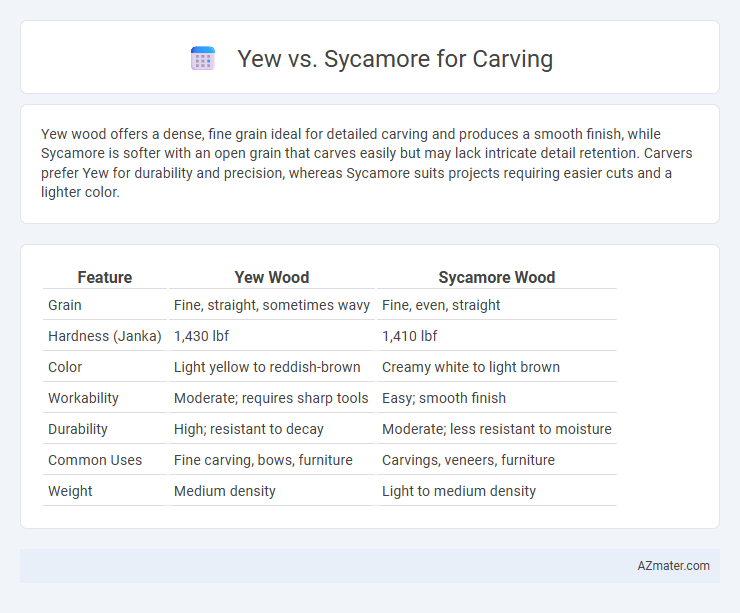Yew wood offers a dense, fine grain ideal for detailed carving and produces a smooth finish, while Sycamore is softer with an open grain that carves easily but may lack intricate detail retention. Carvers prefer Yew for durability and precision, whereas Sycamore suits projects requiring easier cuts and a lighter color.
Table of Comparison
| Feature | Yew Wood | Sycamore Wood |
|---|---|---|
| Grain | Fine, straight, sometimes wavy | Fine, even, straight |
| Hardness (Janka) | 1,430 lbf | 1,410 lbf |
| Color | Light yellow to reddish-brown | Creamy white to light brown |
| Workability | Moderate; requires sharp tools | Easy; smooth finish |
| Durability | High; resistant to decay | Moderate; less resistant to moisture |
| Common Uses | Fine carving, bows, furniture | Carvings, veneers, furniture |
| Weight | Medium density | Light to medium density |
Overview: Yew vs Sycamore for Wood Carving
Yew wood is prized in carving for its fine grain, rich reddish-brown color, and high density, making it ideal for detailed, durable sculptures and functional objects. Sycamore offers a lighter, creamy appearance with a straighter grain and softer texture, facilitating easier carving but with less durability compared to yew. Carvers often choose yew for intricate, long-lasting pieces and sycamore for projects needing smooth finishes and easier shaping.
Wood Anatomy: Yew and Sycamore Compared
Yew wood features a dense, fine-grained heartwood with a warm, reddish-brown hue and a softer, lighter sapwood, making it ideal for detailed carving due to its smooth texture and natural elasticity. In contrast, Sycamore wood exhibits a pale, creamy-white heartwood with a coarser, more uniform grain that is harder and less flexible, offering stability for larger sculptural pieces but requiring sharper tools for precision work. The distinct pore structure and grain patterns of Yew provide a more tactile carving experience, while Sycamore's relatively uniform anatomy supports clean, crisp cuts without significant splintering.
Workability: Carving Ease and Tool Performance
Yew wood offers exceptional carving ease due to its fine grain and moderate hardness, allowing detailed work with minimal tool resistance. Sycamore, while slightly harder, provides a smooth surface that holds intricate patterns well but may dull tools faster during prolonged carving sessions. Both woods respond well to sharp carving tools, but Yew's balance of softness and density typically results in better tool performance and less fatigue for carvers.
Grain and Texture: Detail Potential and Finish
Yew wood features a fine, straight grain with occasional knots, offering detailed carving potential and a smooth finish that highlights its rich, warm tones. Sycamore, characterized by a tighter, interlocked grain and a more uniform texture, allows for precise, intricate designs and results in a polished, creamy surface ideal for detailed decorative work. Both woods respond well to hand and machine tools, but Yew's grain imparts a tactile richness while Sycamore's texture ensures a clean, refined look after finishing.
Durability and Longevity in Carved Pieces
Yew wood offers exceptional durability and resistance to wear, making it a preferred choice for intricate carving projects that require long-lasting detail retention. Sycamore, while easier to carve due to its softer texture, is less dense and more prone to dents and surface damage over time, which can affect the longevity of carved pieces. For artisans prioritizing durability and endurance in their works, yew is a superior option due to its tight grain and natural resilience.
Safety: Toxicity and Allergens in Yew and Sycamore
Yew wood contains toxic compounds called taxines, which pose health risks through inhalation or skin contact during carving, requiring protective gear such as gloves and masks. Sycamore is generally non-toxic but can cause allergic reactions in sensitive individuals, necessitating proper ventilation when carving. Understanding these differences in toxicity and allergen potential is critical for ensuring safety when working with Yew and Sycamore woods.
Availability and Cost for Carvers
Yew wood is moderately available in Europe and offers a fine grain ideal for detailed carving but tends to be more expensive due to limited supply. Sycamore is more widely available across the UK and North America, generally less costly, and favored by carvers for its smooth texture and ease of work. Cost-effectiveness and accessibility make sycamore a practical choice for large or budget-conscious carving projects.
Common Uses: Projects Suited for Each Wood
Yew wood, prized for its fine grain and elasticity, is ideal for intricate carving projects such as detailed figurines, walking sticks, and traditional longbows, where strength and smooth finish are essential. Sycamore, with its coarse yet even texture and pale color, suits larger-scale carvings like furniture, paneling, and decorative architectural elements that benefit from a stable and easily workable material. Both woods offer durability, but Yew's dense properties favor precision crafts, while Sycamore supports robust, functional art pieces.
Artistic Results: Color, Figure, and Aesthetics
Yew wood offers a rich golden-yellow to reddish-brown hue with a fine, straight grain that enhances detailed carving and provides a warm, polished finish ideal for intricate artistic projects. Sycamore, known for its pale cream to light brown color and subtle, interlocking grain, delivers a smooth surface that highlights delicate texture and natural patterns, adding a softly muted elegance to carved pieces. Both woods excel in aesthetics, but Yew's vibrant coloration and distinct grain provide a more striking visual impact, while Sycamore offers understated beauty with consistent tonal variation suitable for refined artistic expressions.
Choosing the Right Wood: Yew or Sycamore for Your Carving Project
Yew wood offers fine grain and durability, making it ideal for detailed carving projects that require strength and smooth finishes. Sycamore provides a softer texture and even grain, perfect for beginners or carvings with intricate patterns needing easy shaping and minimal splintering. Selecting between Yew and Sycamore depends on the project's complexity and the desired balance between hardness and workability.

Infographic: Yew vs Sycamore for Carving
 azmater.com
azmater.com